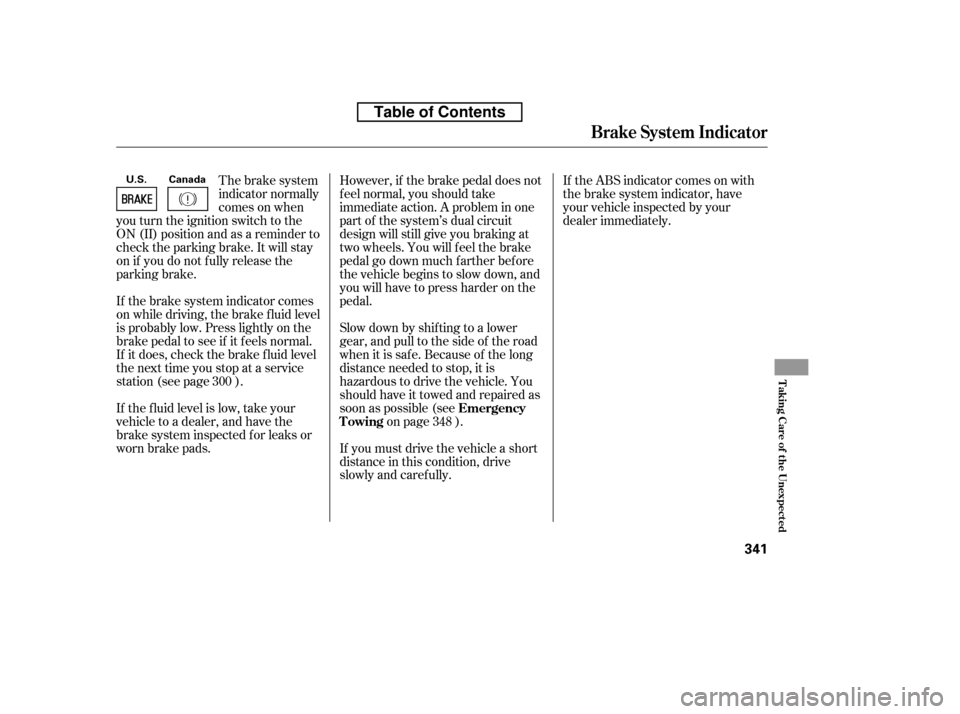Page 351 of 387

CONT INUED
The reading of the vehicle’s
temperature gauge should stay in
the midrange. If it climbs to the red
mark, you should determine the
reason (hot day, driving up a steep
hill, etc.).
If the vehicle overheats, you
should take immediate action. The
only indication may be the
temperature gauge climbing to or
above the red mark. Or you may
see steam or spray coming f rom
under the hood.If you see steam and/or spray
coming f rom under the hood, turn
of f the engine. Wait until you see
no more signs of steam or spray,
then open the hood.
Saf ely pull to the side of the road.
Put the transmission in neutral
(M/T) or Park (A/T), and set the
parking brake. Turn of f all
accessories, and turn on the
hazard warning lights.
1. 2.
If theEngineOverheats
T aking Care of t he Unexpect ed
337
Steam and spray from an
overheated engine can
seriously scald you.
Do not open the hood if steam
is coming out.
Driving with the temperature gauge
reading at the red mark can cause
serious damage to the engine.
Table of Contents
Page 355 of 387

However, if the brake pedal does not
f eel normal, you should take
immediate action. A problem in one
part of the system’s dual circuit
design will still give you braking at
two wheels. You will f eel the brake
pedal go down much f arther bef ore
the vehicle begins to slow down, and
you will have to press harder on the
pedal.
Slow down by shif ting to a lower
gear, and pull to the side of the road
when it is saf e. Because of the long
distance needed to stop, it is
hazardous to drive the vehicle. You
should have it towed and repaired as
soon as possible (seeon page ).
If you must drive the vehicle a short
distance in this condition, drive
slowly and caref ully. If the ABS indicator comes on with
the brake system indicator, have
your vehicle inspected by your
dealer immediately.
The brake system
indicator normally
comes on when
you turn the ignition switch to the
ON (II) position and as a reminder to
check the parking brake. It will stay
on if you do not f ully release the
parking brake.
If the brake system indicator comes
on while driving, the brake f luid level
is probably low. Press lightly on the
brake pedal to see if it f eels normal.
If it does, check the brake f luid level
thenexttimeyoustopataservice
station (see page ).
If the f luid level is low, take your
vehicle to a dealer, and have the
brake system inspected f or leaks or
worn brake pads. 300
348Emergency
Towing
Brake System Indicator
T aking Care of t he Unexpect ed
341
Canada
U.S.
Table of Contents
Page 368 of 387

�µ�µ
�µ �µ�µ �µ �µ�µ�µ�µ�µ�µ�µ�µ�µ�µ
�Î �Î �Î�Î�Î�Î�Î �Î�Î�Î�Î�Î
�Î�Î�Î�Î�Î�Î�Î�Î�Î�Î
�Î
�Î
�Î �Î
Specif ications
T echnical Inf ormation
355
Air Conditioning
Capacities
Lights
Refrigerant type
Charge quantity
Lubricant oil type
HFC-134a (R-134a)
14.1 15.9 oz (400 450 g) SP-10
12 V 60 W (HB3) 12 V 51 W (HB4)
12 V 24/2 CP
12 V 21 W
12 V 21/5 W
12 V 2 CP
12 V 21 W
12 V 3 CP
12 V 21 W
4.8 US qt (4.5
)
1.8 US qt (1.7
)
1.6 US qt (1.5
)
1.19 US gal (4.5
)
1.80 US gal (6.8
)
4.6 US qt (4.4
)
4.4 US qt (4.2
)
5.8 US qt (5.5
)
6.08 US qt (5.75
)
2.5 US qt (2.4)
1.40 US gal (5.3
)
1.77 US gal (6.7
)
2.6 US qt (2.5
)
1.7 US qt (1.6
)
1.5 US qt (1.4
)
1.37 US gal (5.2
)
1.72 US gal (6.5
)
3.9 US qt (3.7
)
3.7 US qt (3.5
)
4.8 US qt (4.5
)
13.2 US gal (50
)
Fuel tank
Engine
coolant
Engine oil Manual
transmission
fluid Automatic
transmission
fluid
Windshield
washer
reservoir Headlights
Front turn signal/side marker/
Parking lights
Rear turn signal lights
Stop/Taillights
Rear side marker lights
Back-up lights
Taillights
High-mount brake light
Fog lights
License plate lights
Ceiling light
Spotlights
Trunk light 12 V
12 V
12 V
12 V
5W
8W
8W
5W
12 V 55 W
Including the coolant in the reserve tank and that remaining in the
engine
Reserve tank capacity: 0.11 US gal (0.4
)
Excluding the oil remaining in the engine High Low
A/T
M/T
A/T
M/T
Change Total
U.S. Vehicles
Canada
Vehicles Approx.
Except Si
Change
Including filter
Without filter
Total
ChangeTotal
Change Total (Amber)
(Amber)
(H11)
Si
Except DX, Canadian DX-G
1: 2: 3:4:5:
13
34334
3434343434
2
4
5 3
Table of Contents
Page 380 of 387
Select a nearby lightly traveled
major highway where you can
maintain a speed of 50 to 60 mph
(80to97km/h)foratleast20
minutes. Drive on the highway in
D (automatic) or 5th (manual). Do
notusethecruisecontrol.When
traffic allows, drive for 90 seconds
without moving the accelerator
pedal. (Vehicle speed may vary
slightly; this is okay.) If you cannot
do this f or a continuous 90
seconds because of traf f ic
conditions, drive f or at least 30
seconds, then repeat it two more
times (for a total of 90 seconds).Then drive in city/suburban
traffic for at least 10 minutes.
When traf f ic conditions allow, let
the vehicle coast f or several
seconds without using the
accelerator pedal or the brake
pedal.
Make sure the vehicle has been
parked with the engine of f f or 30
minutes.
If the testing f acility determines the
readiness codes are still not set, see
your dealer.
7.
8. 9.
Emissions T est ing
T echnical Inf ormation
367
Table of Contents